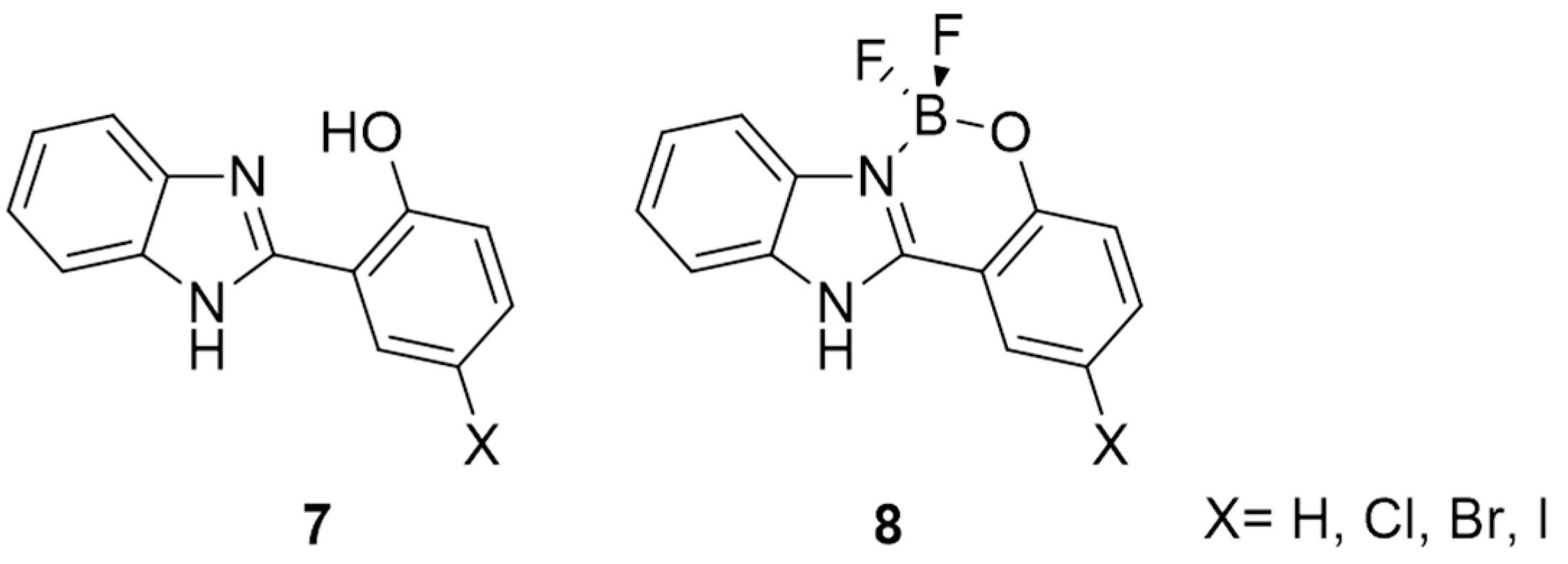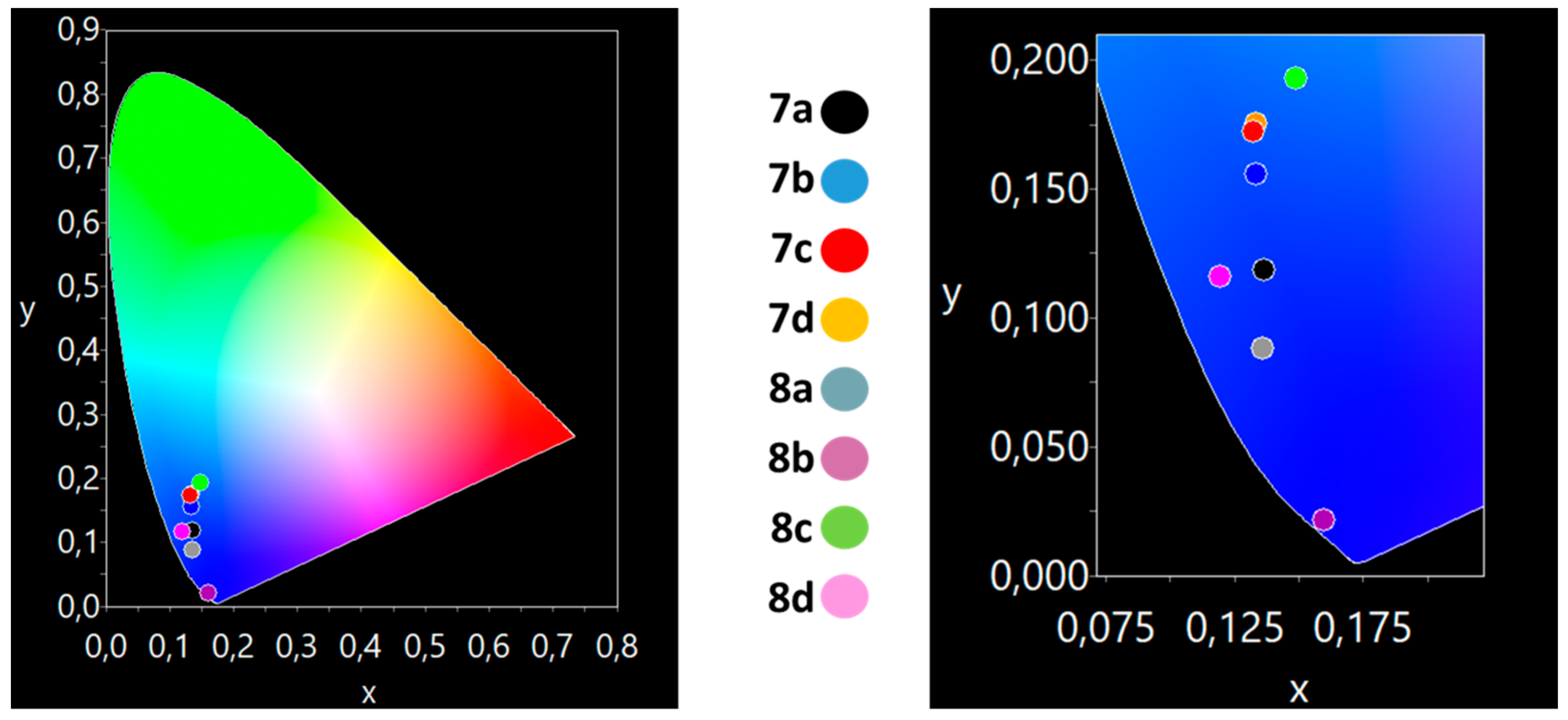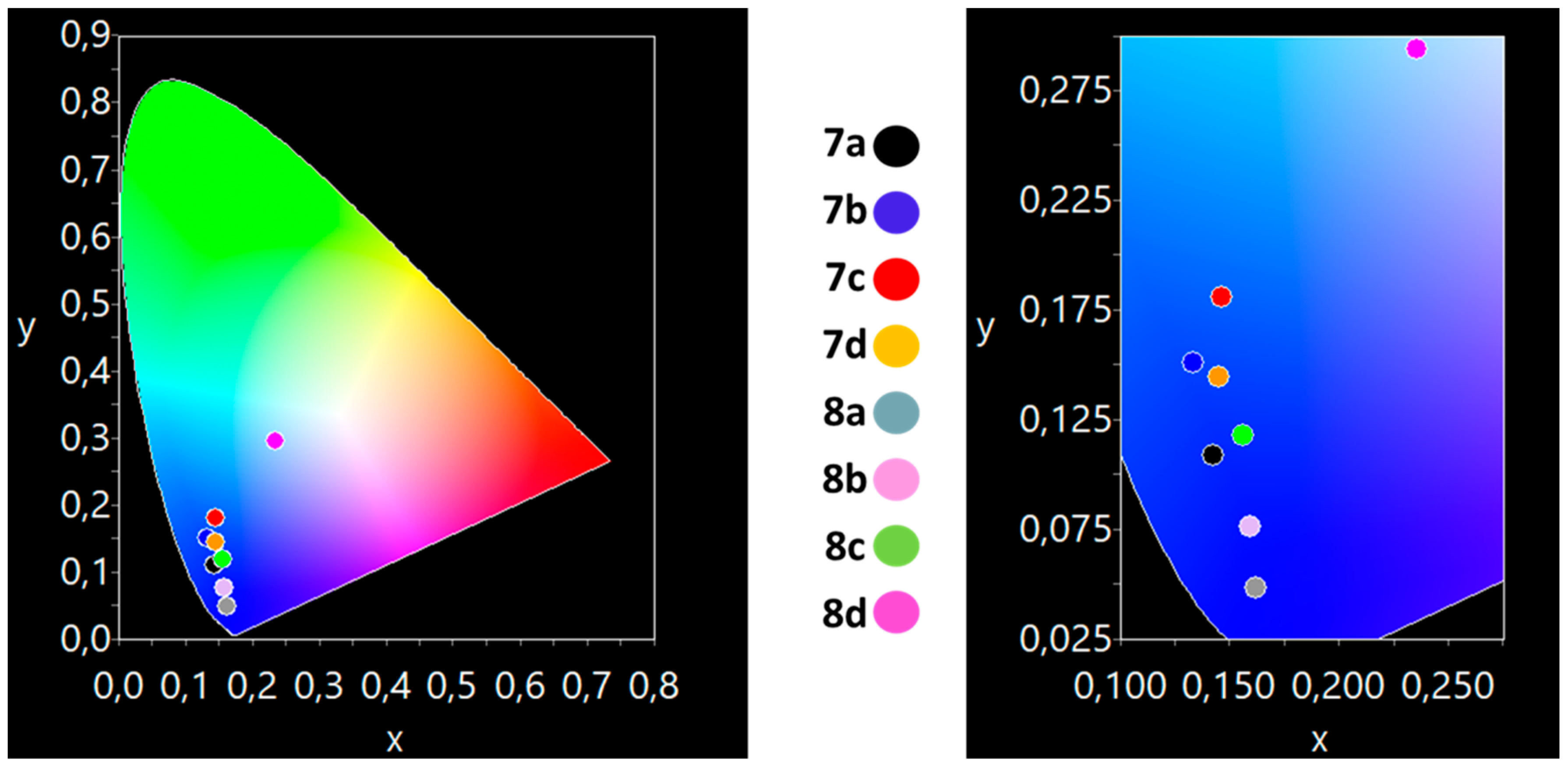Benzimidazole-Based N,O Boron Complexes as Deep Blue Solid-State Fluorophores
Abstract
:1. Introduction
2. Materials and Methods
2.1. Materials and Methods
2.2. Synthesis
2.2.1. General Procedure for the Synthesis of Ligands 7a–d
2.2.2. General Procedure for the Synthesis of Complexes 8a–d
3. Results and Discussion
3.1. Synthesis
3.2. Photophysical Properties
4. Conclusions
Supplementary Materials
Author Contributions
Funding
Institutional Review Board Statement
Informed Consent Statement
Data Availability Statement
Acknowledgments
Conflicts of Interest
References
- Cansu-ergun, E.G. Chemical insight into benzimidazole containing donor-acceptor-donor type π-conjugated polymers: Benzimidazole as an acceptor. Polym. Rev. 2018, 58, 42–62. [Google Scholar] [CrossRef]
- Burganov, T.I.; Zhukova, N.A.; Mamedov, V.A.; Bannwarth, C.; Grimme, S.; Katsyuba, S.A. Benzimidazolylquinoxalines: Novel fluorophores with tuneable sensitivity to solvent effects. Phys. Chem. Chem. Phys. 2017, 19, 6095–6104. [Google Scholar] [CrossRef] [PubMed] [Green Version]
- Xu, B.; Li, Y.; Song, P.; Ma, F.; Sun, M. Photoactive layer based on T-shaped benzimidazole dyes used for solar cell: From photoelectric properties to molecular design. Nat. Sci. Rep. 2017, 7, 45688. [Google Scholar] [CrossRef] [PubMed] [Green Version]
- Reddy, S.S.; Cho, W.; Sree, V.G.; Jin, S. Multi-functional highly efficient bipolar 9,9-dimethyl-9,10-dihydroacridine/imidazole-based materials for solution-processed organic light-emitting diode applications. Dyes Pigment. 2016, 134, 315–324. [Google Scholar] [CrossRef]
- Bodedla, G.B.; Thomas, K.R.J.; Fan, M.; Ho, K. Benzimidazole-Branched Isomeric Dyes: Effect of Molecular Constitution on Photophysical, Electrochemical, and Photovoltaic Properties. J. Org. Chem. 2016, 81, 640–653. [Google Scholar] [CrossRef] [Green Version]
- Kulhánek, J.; Bures, F.; Pytela, O.; Mikysek, T.; Ludvík, J. Imidazole as a donor/acceptor unit in charge-transfer chromophores with extended π-linkers. Chem. Asian J. 2011, 6, 1604–1612. [Google Scholar] [CrossRef]
- Lai, M.; Chen, C.; Huang, W.; Lin, J.T.; Ke, T.; Chen, L.; Tsai, M.; Wu, C. Benzimidazole/Amine-based compounds capable of ambipolar transport for application in single-layer blue-emitting oleds and as hosts for phosphorescent emitters. Angew. Chem. Int. Ed. 2008, 47, 581–585. [Google Scholar] [CrossRef]
- Sim, B.R.; Kim, B.-G.; Lee, J.K.; Do, J.Y. Photovoltaic properties of benzimidazole-derived perylene imides as an n-type material. Thin Solid Films 2011, 519, 8091–8094. [Google Scholar] [CrossRef]
- Liu, Y.; Gao, Z.; Wang, Z.; Feng, C.; Shen, F.; Lu, P.; Ma, Y. Synthesis and characterization of an imidazole-containing pyrene π-system. Eur. J. Org. Chem. 2013, 32, 7267–7371. [Google Scholar] [CrossRef]
- Chen, L.; Yin, S.-Y.; Pan, M.; Wu, K.; Wang, H.-P.; Fan, Y.-N.; Su, C.-Y. A naked eye colorimetric sensor for alcohol vapor discrimination and amplified spontaneous emission (ASE) from a highly fluorescent excited-state intramolecular proton transfer (ESIPT) molecule. J. Mater. Chem. C 2016, 4, 6962–6966. [Google Scholar] [CrossRef]
- Nieto, C.I.; Cabildo, P.; García, M.Á.; Claramunt, R.M.; Alkorta, I.; Elguero, J. An experimental and theoretical NMR study of NH-benzimidazoles in solution and in the solid state: Proton transfer and tautomerism. Beilstein J. Org. Chem. 2014, 10, 1620–1629. [Google Scholar] [CrossRef]
- Chipem, F.A.S.; Behera, S.K.; Krishnamoorthy, G. Excited state proton transfer of 2-(2′-hydroxyphenyl)benzimidazole and its nitrogen substituted analogues in bovine serum albumin. Photochem. Photobiol. Sci. 2014, 13, 1297–1304. [Google Scholar] [CrossRef]
- Forés, M.; Duran, M.; Solà, M.; Orozco, M.; Luque, F.J. Theoretical evaluation of solvent effects on the conformational and tautomeric equilibriaof 2-(2′-hydroxyphenyl)benzimidazole and on its absorption and fluorescence spectra. J. Phys. Chem. A 1999, 103, 4525–4532. [Google Scholar] [CrossRef]
- Qin, M.; Jin, D.; Che, W.; Jiang, Y.; Zhang, L.; Zhu, D.; Su, Z. Fluorescence response and detection of Cu2+ with 2-(2-hydroxyphenyl)benzimidazole in aqueous medium. Inorg. Chem. Commun. 2017, 75, 25–28. [Google Scholar] [CrossRef]
- Vaz, P.A.A.M.; Rocha, J.; Silva, A.M.S.; Guieu, S. Difluoroborate complexes based on 2′-hydroxyphenones as solid-state fluorophores. Dyes Pigment. 2021, 184, 108720. [Google Scholar] [CrossRef]
- Vaz, P.A.A.M.; Rocha, J.; Silva, A.M.S.; Guieu, S. Aggregation-induced emission enhancement of chiral boranils. New J. Chem. 2018, 42, 18166–18171. [Google Scholar] [CrossRef]
- Guieu, S.; Pinto, J.; Silva, V.L.M.; Rocha, J.; Silva, A.M.S. Synthesis, post-modification and fluorescence properties of boron diketonate complexes. Eur. J. Org. Chem. 2015, 2015, 3423–3426. [Google Scholar] [CrossRef]
- Cardona, F.; Rocha, J.; Silva, A.M.S.; Guieu, S. Δ1-pyrroline based boranyls: Synthesis, crystal structures and luminescent properties. Dyes Pigment. 2014, 111, 16–20. [Google Scholar] [CrossRef]
- Costa, L.D.; Guieu, S.; Rocha, J.; Silva, A.M.S.; Tomé, A.C. Porphyrin–boron diketonate dyads. New J. Chem. 2017, 41, 2186–2192. [Google Scholar] [CrossRef]
- Cui, Y.; Wang, S. Diboron and triboron compounds based on linear and star-shaped conjugated ligands with 8-hydroxyquinolate functionality: impact of intermolecular interaction and boron coordination on luminescence. J. Org. Chem. 2006, 71, 6485–6496. [Google Scholar] [CrossRef]
- Dhanunjayarao, K.; Mukundam, V.; Ramesh, M.; Venkatasubbaiah, K. Synthesis and optical properties of salicylaldimine-based diboron complexes. Eur. J. Inorg. Chem. 2014, 2014, 539–545. [Google Scholar] [CrossRef]
- Guieu, S.; Cardona, F.; Rocha, J.; Silva, A.M.S. Luminescent bi-metallic fluoroborate derivatives of bulky salen ligands. New J. Chem. 2014, 38, 5411–5414. [Google Scholar] [CrossRef]
- Li, G.; Lou, W.; Wang, D.; Deng, C.; Zhang, Q. Difluoroboron-enabled thermally activated delayed fluorescence. ACS Appl. Mater. Interfaces 2019, 11, 32209–32217. [Google Scholar] [CrossRef]
- Azarias, C.; Budzák, Š.; Laurent, A.D.; Ulrich, G.; Jacquemin, D. Tuning ESIPT fluorophores into dual emitters. Chem. Sci. 2016, 7, 3763–3774. [Google Scholar] [CrossRef] [Green Version]
- Sedgwick, A.C.; Wu, L.; Han, H.H.; Bull, S.D.; He, X.P.; James, T.D.; Sessler, J.L.; Tang, B.Z.; Tian, H.; Yoon, J. Excited-state intramolecular proton-transfer (ESIPT) based fluorescence sensors and imaging agents. Chem. Soc. Rev. 2018, 47, 8842–8880. [Google Scholar] [CrossRef] [Green Version]
- Kim, T.-I.; Kang, H.J.; Han, G.; Chung, S.J.; Kim, Y. A highly selective fluorescent ESIPT probe for the dual specificity phosphatase MKP-6. Chem. Commun. 2009, 2, 5895–5897. [Google Scholar] [CrossRef]
- Li, X.; Son, Y.-A. Efficient luminescence from easily prepared fluorine–boron core complexes based on benzothiazole and benzoxazole. Dyes Pigment. 2014, 107, 182–187. [Google Scholar] [CrossRef]
- Massue, J.; Ulrich, G.; Ziessel, R. Effect of 3,5-disubstitution on the optical properties of luminescent 2-(2′-hydroxyphenyl)benzoxazoles and their borate complexes. Eur. J. Org. Chem. 2013, 2013, 5701–5709. [Google Scholar] [CrossRef]
- Massue, J.; Frath, D.; Ulrich, G.; Retailleau, P.; Ziessel, R. Synthesis of luminescent 2-(2′-hydroxyphenyl)benzoxazole (hbo) borate complexes. Org. Lett. 2012, 14, 230–233. [Google Scholar] [CrossRef]
- Frath, D.; Massue, J.; Ulrich, G.; Ziessel, R. Luminescent materials: Locking π-conjugated and heterocyclic ligands with boron(III). Angew. Chem. Int. Ed. 2014, 53, 2290–2310. [Google Scholar] [CrossRef] [PubMed]
- Mukundam, V.; Dhanunjayarao, K.; Samal, S.; Venkatasubbaiah, K. Variation of para substituent on 2-phenol of tetraaryl-substituted imidazole-boron difluoride complexes: Synthesis, characterization, and photophysical properties. Asian J. Org. Chem. 2017, 6, 1054–1062. [Google Scholar] [CrossRef]
- Benelhadj, K.; Massue, J.; Retailleau, P.; Ulrich, G.; Ziessel, R. 2-(2′-Hydroxyphenyl)benzimidazole and 9,10-phenanthroimidazole chelates and borate complexes: Solution- and solid-state emitters. Org. Lett. 2013, 15, 2918–2921. [Google Scholar] [CrossRef]
- Dhanunjayarao, K.; Mukundam, V.; Venkatasubbaiah, K. tetracoordinate imidazole-based boron complexes for the selective detection of picric acid. Inorg. Chem. 2016, 55, 11153–11159. [Google Scholar] [CrossRef]
- Xu, H.; Xu, Z.-F.; Yue, Z.-Y.; Yan, P.-F.; Wang, B.; Jia, L.-W.; Li, G.-M.; Sun, W.-B.; Zhang, J.-W. A novel deep blue-emitting znii complex based on carbazole-modified 2-(2-hydroxyphenyl)benzimidazole: Synthesis, bright electroluminescence, and substitution effect on photoluminescent, thermal, and electrochemical properties. J. Phys. Chem. C 2008, 112, 15517–15525. [Google Scholar] [CrossRef]
- Esparza-Ruiz, A.; Peña-Hueso, A.; Nöth, H.; Flores-Parra, A.; Contreras, R. Boron coordination compounds derived from 2-phenyl-benzimidazole and 2-phenyl-benzotriazole bidentate ligands. J. Organomet. Chem. 2009, 694, 3814–3822. [Google Scholar] [CrossRef]
- Bolton, O.; Lee, K.; Kim, H.-J.; Lin, K.Y.; Kim, J. Activating efficient phosphorescence from purely organic materials by crystal design. Nat. Chem. 2011, 3, 205–210. [Google Scholar] [CrossRef]
- Ouyang, J.; Ouyang, C.; Fujii, Y.; Nakano, Y.; Shoda, T.; Nagano, T. Synthesis and fluorescent properties of 2-(1H-benzimidazol-2-yl)-phenol derivatives. J. Heterocycl. Chem. 2004, 41, 359–365. [Google Scholar] [CrossRef]
- Alaqeel, S.I. Synthetic approaches to benzimidazoles from o-phenylenediamine: A literature review. J. Saudi Chem. Soc. 2017, 21, 229–237. [Google Scholar] [CrossRef] [Green Version]
- Resch-Genger, U.; Rurack, K. Determination of the photoluminescence quantum yield of dilute dye solutions (IUPAC Technical Report). Pure Appl. Chem. 2013, 85, 2005–2013. [Google Scholar] [CrossRef]
- Manojai, N.; Daengngern, R.; Kerdpol, K.; Ngaojampa, C.; Kungwan, N. Heteroatom effect on photophysical properties of 2-(2′-hydroxyphenyl)benzimidazole and its derivatives as fluorescent dyes: A TD-DFT study. J. Lumin. 2017, 188, 275–282. [Google Scholar] [CrossRef]
- Akutsu, K.; Mori, S.; Shinmei, K.; Iwase, H.; Nakano, Y.; Fujii, Y. Investigation of substitution effect on fluorescence properties of Zn2+-selective ratiometric fluorescent compounds: 2-(2-Hydroxyphenyl)benzimidazole derivatives. Talanta 2016, 146, 575–584. [Google Scholar] [CrossRef] [PubMed]
- Padalkar, V.S.; Ramasami, P.; Sekar, N. A comprehensive spectroscopic and computational investigation of intramolecular proton transfer in the excited states of 2-(2-hydroxyphenyl) benzoxazole and its derivatives. J. Lumin. 2014, 146, 527–538. [Google Scholar] [CrossRef]
- Chipem, F.A.S.; Dash, N.; Krishnamoorthy, G. Role of nitrogen substitution in phenyl ring on excited state intramolecular proton transfer and rotamerism of 2-(2-hydroxyphenyl)benzimidazole: A theoretical study. J. Chem. Phys. 2011, 134, 104308. [Google Scholar] [CrossRef]
- Wang, R.; Liu, D.; Xu, K.; Li, J. Substituent and solvent effects on excited state intramolecular proton transfer in novel 2-(2′-hydroxyphenyl)benzothiazole derivatives. J. Photochem. Photobiol. A 2009, 205, 61–69. [Google Scholar] [CrossRef]
- Fontes, L.F.B.; Nunes da Silva, R.; Silva, A.M.S.; Guieu, S. Unsymmetrical 2,4,6-triarylpyridines as versatile scaffolds for deep-blue and dual emission fluorophores. ChemPhotoChem 2020, 4, 5312–5317. [Google Scholar] [CrossRef]
- Chen, K.-Y.; Hsieh, C.-C.; Cheng, Y.-M.; Lai, C.-H.; Chou, P.-T. Extensive spectral tuning of the proton transfer emission from 550 to 675 nm via a rational derivatization of 10-hydroxybenzo[h]quinoline. Chem. Commun. 2006, 1, 4395–4397. [Google Scholar] [CrossRef]
- Foley, S.; Berberan-Santos, M.N.; Fedorov, A.; Bensasson, R.V.; Leach, S.; Gigante, B. Effect of halogenated compounds on the photophysics of C70 and a monoadduct of C70: Some implications on optical limiting behaviour. Chem. Phys. 2001, 263, 437–447. [Google Scholar] [CrossRef]
- Zhang, Z.; Zhang, H.; Jiao, C.; Ye, K.; Zhang, H.; Zhang, J.; Wang, Y. 2-(2-hydroxyphenyl)benzimidazole-based four-coordinate boron-containing materials with highly efficient deep-blue photoluminescence and electroluminescence. Inorg. Chem. 2015, 54, 2652–2659. [Google Scholar] [CrossRef]
- Yang, X.; Xu, X.; Zhou, G. Recent advances of the emitters for high performance deep-blue organic light-emitting diodes. J. Mater. Chem. C 2015, 3, 913–944. [Google Scholar] [CrossRef]
- ITU-R Recommendation BT.1700, Characteristics of Composite Video Signals for Conventional Analogue Television Systems. 2004. Available online: https://www.itu.int/rec/R-REC-BT.1700-0-200502-I/en (accessed on 1 March 2021).








| Dye | λabs (nm) 1 | ε (M−1 cm−1) 2 | λem (nm) 3 | δλst | φf 4 (%) | Solvent |
|---|---|---|---|---|---|---|
| 7a | 333 | 65,600 | 460 | 127 | 93 | DMSO |
| 325 | - | 455 | 130 | 39 | Solid | |
| 7b | 341 | 76,500 | 466 | 125 | 95 | DMSO |
| 325 | - | 466 | 141 | 18 | Solid | |
| 7c | 341 | 55,700 | 467 | 126 | 33 | DMSO |
| 325 | - | 466 | 141 | 5 | Solid | |
| 7d | 343 | 46,800 | 470 | 127 | 4 | DMSO |
| 325 | - | 500 | 175 | <1 | Solid | |
| 8a | 336 | 55,300 | 360 | 24 | 75 | DMSO |
| 325 | - | 380 | 55 | 12 | Solid | |
| 8b | 344 | 83,900 | 370 | 26 | 26 | DMSO |
| 325 | - | 420 | 95 | 2 | Solid | |
| 8c | 345 | 82,300 | 361 | 16 | 1 | DMSO |
| 325 | - | 395 | 70 | 2 | Solid | |
| 8d | 345 | 91,300 | 370 | 25 | <1 | DMSO |
| 325 | - | 500 | 175 | <1 | Solid |
| Compound | Day Light | 254 nm | 365 nm |
|---|---|---|---|
| 7a |  |  |  |
| 7b |  |  |  |
| 7c |  |  |  |
| 7d |  |  |  |
| 8a |  |  |  |
| 8b |  |  |  |
| 8c |  |  |  |
| 8d |  |  |  |
Publisher’s Note: MDPI stays neutral with regard to jurisdictional claims in published maps and institutional affiliations. |
© 2021 by the authors. Licensee MDPI, Basel, Switzerland. This article is an open access article distributed under the terms and conditions of the Creative Commons Attribution (CC BY) license (https://creativecommons.org/licenses/by/4.0/).
Share and Cite
Vaz, P.A.A.M.; Rocha, J.; Silva, A.M.S.; Guieu, S. Benzimidazole-Based N,O Boron Complexes as Deep Blue Solid-State Fluorophores. Materials 2021, 14, 4298. https://doi.org/10.3390/ma14154298
Vaz PAAM, Rocha J, Silva AMS, Guieu S. Benzimidazole-Based N,O Boron Complexes as Deep Blue Solid-State Fluorophores. Materials. 2021; 14(15):4298. https://doi.org/10.3390/ma14154298
Chicago/Turabian StyleVaz, Patrícia A. A. M., João Rocha, Artur M. S. Silva, and Samuel Guieu. 2021. "Benzimidazole-Based N,O Boron Complexes as Deep Blue Solid-State Fluorophores" Materials 14, no. 15: 4298. https://doi.org/10.3390/ma14154298







